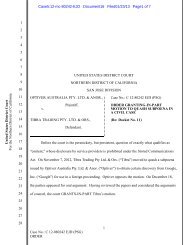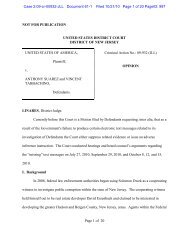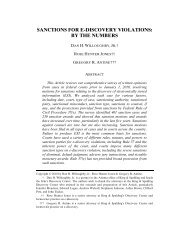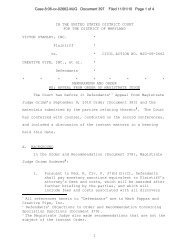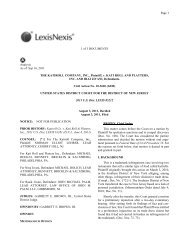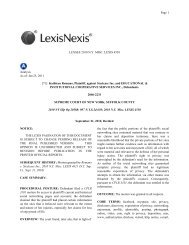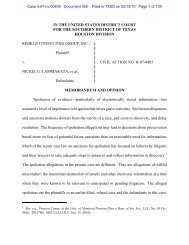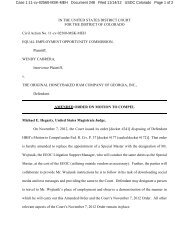Pippins v. KPMG, No. 11-377 - E-Discovery Law Alert
Pippins v. KPMG, No. 11-377 - E-Discovery Law Alert
Pippins v. KPMG, No. 11-377 - E-Discovery Law Alert
Create successful ePaper yourself
Turn your PDF publications into a flip-book with our unique Google optimized e-Paper software.
Case 1:<strong>11</strong>-cv-00<strong>377</strong>-CM-JLC Document 106 Filed 10/07/<strong>11</strong> Page 8 of 19<br />
agree to a methodology to obtain an appropriate sample. (ld. at 18). Plaintiffs further request<br />
that the Court give "the parties guidance about how to proceed." (ld.).<br />
III.<br />
DISCUSSION<br />
A. Legal Standards Governing Protective Orders and Preservation<br />
Federal Rule of Civil Procedure 26(c) authorizes a federal court to issue a protective<br />
order "for good cause ... to protect a party or person from annoyance, embarrassment,<br />
oppression, or undue burden or expense."<br />
S.E.C. v. Rajaratnam, 622 F.3d 159; 181 (2d Cir.<br />
2010) (enumerating the measures that a district court may take to protect legitimate interests in<br />
course of discovery). The party seeking a protective order pursuant to Rule 26(c) bears the<br />
burden to establish the existence of good cause necessitating the order. See Gambale v.<br />
Deutsche Bank AG, <strong>377</strong> F.3d 133, 142 (2d Cir. 2004) (citing In re Agent Orange Prod. Liab.<br />
Litig., 821 F.2d 139, 145 (2d Cir. 1987)). Good cause exists when a party seeking the protective<br />
order can articulate'" a clearly defined, specific and serious injury'" that will result in the<br />
absence of the order. In re Terrorist Attacks on September 1 L 2001,454 F. Supp. 2d 220,222<br />
(S.D.N.Y. 2006) (quoting Shingara v. Skiles, 420 F.3d 301,306 (3d CiT. 2005)); =-===<br />
Parmalat Sees. Litig., 258 F.R.D. 236,244 (S.D.N. Y. 2009) ("broad allegations ofhann<br />
unsubstantiated by specifie examples or articulated reasoning fail to satisfy the test") (eitations<br />
omitted). Although the party seeking the protective order bears the burden ofestablishing good<br />
cause, the court must weigh the interests of both parties in considering the necessity and scope of<br />
the order. See Mitchell v. Fishbein, 227 F.R.D. 239, 245 (S.D.N.Y. 2005) ("'[U]nder Rule 26(c),<br />
the appropriateness of protective relief from discovery depends upon a balancing of the litigation<br />
needs of the discovering party and any countervailing protectable interests of the party from<br />
8



